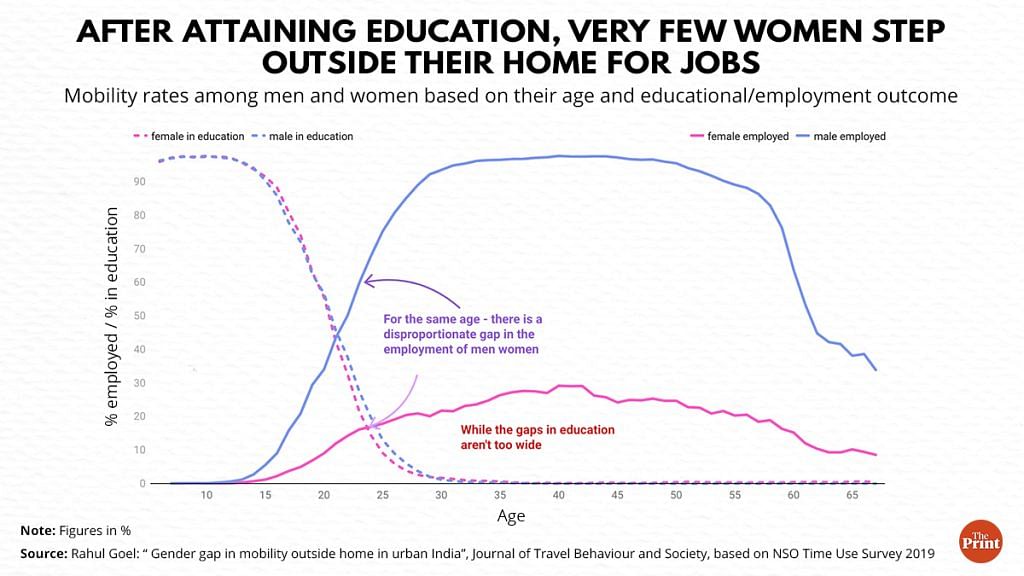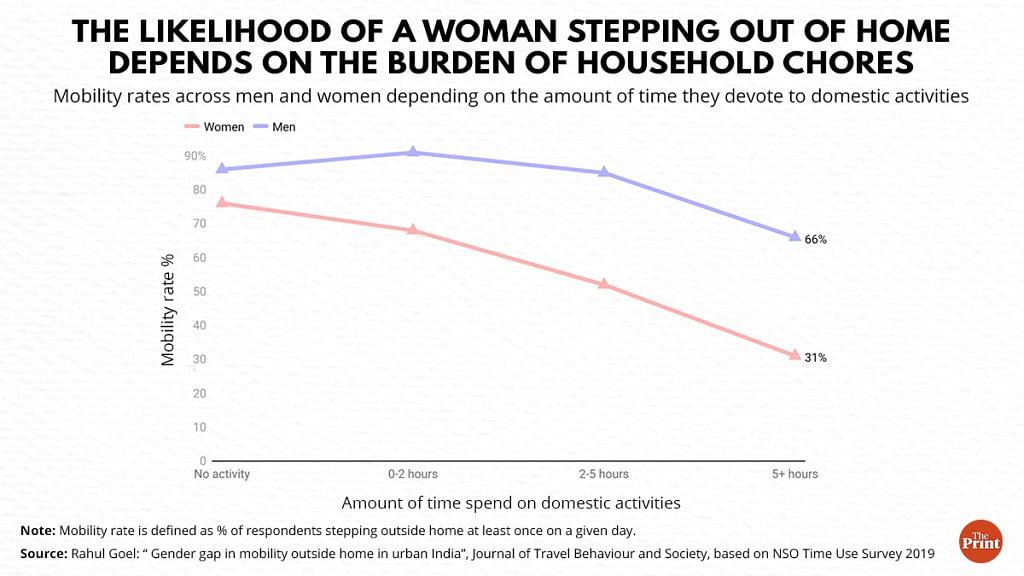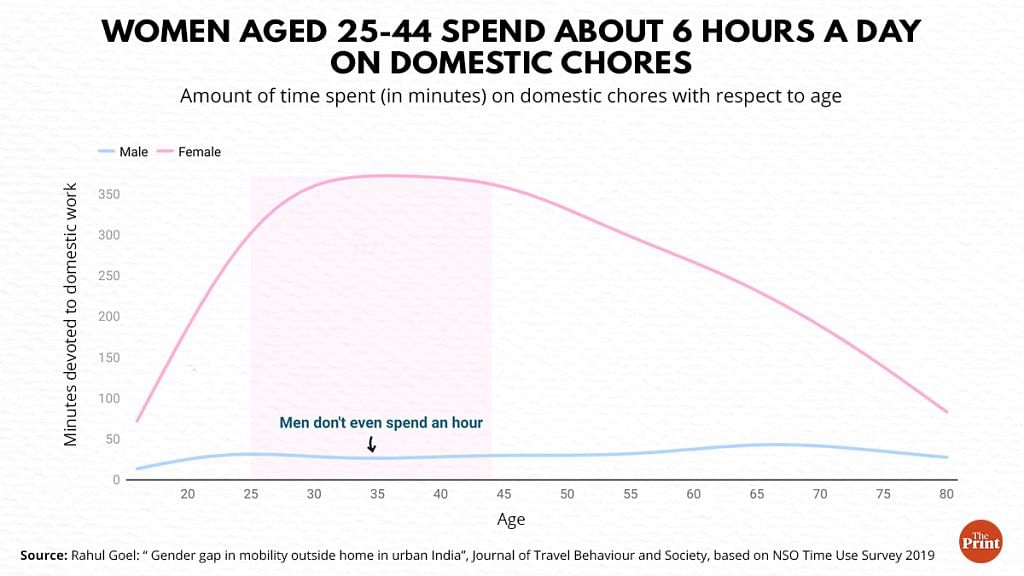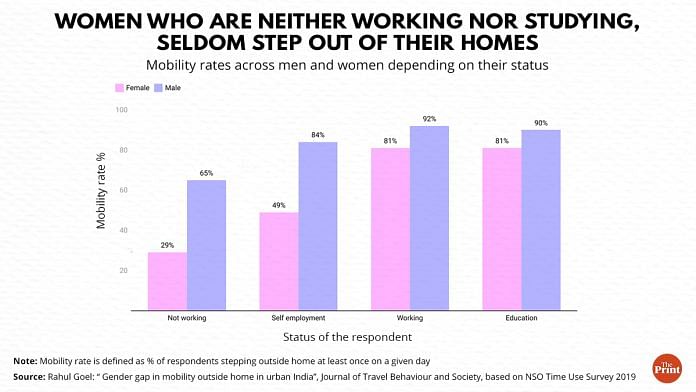New Delhi: Women’s participation at work in India has been relatively low, placing the country at the bottom of several gender gap indices. Women are particularly missing in industrial and manufacturing jobs, which are the backbone of our economy. If women are not present at work — where are they? At home, says a new study.
According to a paper titled ‘Gender gap in mobility outside home in urban India’, published in Science Direct’s journal Travel Behaviour and Society on Friday, nearly half of the women in urban India say that they did not step out of their homes even once on a given day.
The study, authored by Rahul Goel of IIT Delhi’s Transportation Research and Injury Prevention Centre, also showed that there exist wide gaps in mobility among men and women in India which he cites as ‘rare’ in the world.
Also Read: More women students now study STEM courses in IITs, NITs & other universities, shows govt data
Key findings
The study is based on the findings of the 2019 round of Time Use Survey (TUS) that the Ministry of Statistics and Programme Implementation conducted covering over 1.38 lakh households spread across India. Goel’s study focuses on urban India, the sample size of which is about 84,207 women and 88,914 men.
Using the TUS dataset, Goel calculated the mobility rate, defined as the percentage of respondents reporting at least one trip in a day made outside their homes.
The study shows that on a normal day, only about 47 per cent female respondents reported to have stepped out of their homes at least once in a day. This means that about 53 per cent did not step out on a normal day even once. The proportion of men who reported having stepped out at least once a day was about 87 per cent, which means only a small number of them are likely to stay at home on a given day.
Dependence on a variety of factors
The study maintains that women need solid reasons to step out of their homes, which is not necessarily the case for men.
For instance, among women who are enrolled in education, 81 per cent were reported to have made at least one trip outside their home. It was 90 per cent for men. Once they are out of the education system, their likelihood of stepping outside home depends on employment outcomes.
About 81 per cent of working women reported at least one trip outside home on a given day, compared with 92 per cent for men. But what if a woman doesn’t work? Among such women, who are neither employed, nor studying anymore, barely 30 per cent report a trip on a given day. This means that about 70 per cent of such women don’t step out even once in a day. On the other hand, only 35 per cent of ‘not working’ men remain at homes.
This wouldn’t have been a big problem if the percentage of women not working was low, but in India that’s not the case. Of the sample distribution, 61.9 per cent women were in the ‘not working’ category as against only 12.4 per cent men, and 11 per cent women and 38 per cent men were in the ‘working’ category, respectively.
This is also visible in the respondents dataset in the survey. The study shows that as both men and women age, their enrollment in education declines and is almost negligible after the age of 25. At that age, there is a significant rise of men in employment, but it doesn’t sharply rise for women.

At the age of 26, about 80.7 per cent of the male respondents were employed, but it was just 19.1 per cent for women. Throughout working age and before retirement (60), the gap between men and women’s employment continues to stay wide.
Are women stuck at home because of chores?
The survey also reveals key highlights on how Indians spend their time. Data revealed over 52 per cent of the female respondents spent more than 5 hours in domestic chores. These chores include cooking, cleaning, maintaining/do-it-yourself home decor etc. The share of men spending such a significant amount of time on unpaid labour was just 1.5 per cent.
This also impacts women’s mobility. According to Goel, “because they are doing so many activities at home, they can’t take up activities outside home. If your childcare is being done at no cost by women in the household — compared to you paying for it in a developed country — then our cost realisation of what women do at home would be much greater. Since women do these activities for free, we tend to underestimate their importance.”
The study showed that as the time spent on doing household chores increases, the percentage of women stepping out also decreases. About 76 per cent women report a trip outside home on a day if they spent no time doing domestic activities. This falls to just 31 per cent of women reporting a trip outside home who spend more than 5 hours doing daily unpaid labour at home.

Here also we have huge gender gaps — because even among the very few men (1.5 per cent) who spend more than 5 hours on domestic activities — about two-thirds reported at least one trip outside home.
Men are also far less likely to do any household chores than women, the study found.
The dataset as seen by ThePrint shows that women aged 25-44 spend around 6 hours on domestic chores on a daily basis. For the same age group of men, it’s just 28.4 minutes (or half an hour) a day.

Low mobility of women in public spaces
Extant research on the low mobility of women in public spaces has prompted the policy makers to take decisions that get them out of their homes. In many states, including Delhi, public transportation is often provided at a concession to women.
Safety factor also offers explanations on why women don’t step out without a purpose. Research has shown that most of the sexual harassment women face also happens at public places — which are touted to be unsafe for women especially in urban areas.
This is also where the role of gender sensitivity in public infrastructure comes in.
“There should be gender sensitivity in our infrastructural investments. We need more public places which are accessible and safer for women,” Lekha Chakraborty, Professor at the National Institute of Public Finance and Policy, told ThePrint.
She also added that the public policy directed towards increasing women’s participation in gainful employment must also address the caregiving economy.
“The government must not act solely as the employer of the last resort. The burden of caregiving which is tilted on women’s shoulders could be institutionalised and should invite investments from policy makers. To counter gender gaps in domestic chores — we need more social awareness campaigns to make people understand that domestic work is not gendered. Sharing responsibilities is economically beneficial,” Chakraborty asserted.
(Edited by Geethalakshmi Ramanathan)
Also Read: What reports on Indian women’s falling participation in labour force don’t tell you




